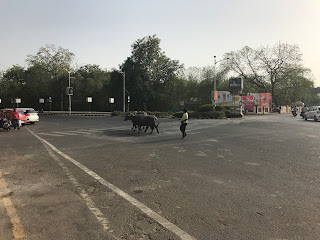The Sacred Cattle
Today we head for Ahmedabad, India. We arrive at the airport on time and as has become routine we are delayed. This time we have to wait for ADIZ clearance numbers from Pakistan and India as well,as a a FIC number, this despite us providing the flight plan tomGerry Dnata's the night before, specifically for this reason.
So we finally get clearance and head for VAAH, Ahmedabad. On take off we must watch out for Runway incursions! The haze is present again, this time it appears to be smoke, but we cannot be certain. The haze is extensive. The city turns to fields which at first are green but slowly turn to brown. Thirty minutes into our flight we are notified that a Notam has been issued which states that VAAH is closed, we have to decide what we are going to do, fly to an alternate or head back. As our alternate is not a point of entry we turn back to Karachi, this is going to expensive, we have already paid Karachi $700 plus today. While heading back to Karachi ATC contact us again and now say the VAAH will,take us after all. So we turn back around and head to VAAH.
Our journey takes us over whatnare said to be the largest salt flat desserts in the world, the salt is inhospitable,,and we do not see and life below. These slat plains appear to create large updraft sand down drafts which make for and uncomfortable ride. We decide to fly the last half of the trip without the HeliSAS engaged. As get closer to Ahmedabad the towns get larger and more numerous. We can also see cattle grazing in the fields and cooling of in the small pools of water below.
Landing in Ahmedabad we allow another aircraft to overtake us before landing on RWY 25. After landing we discover that theynhavenisssued a penalty to us of $100 for landing at the "closed" airport. Anyway after clearing immigration we head to our hotel the Comfort Inn by the airport.
After a quick rest we decide to find an ATM and check out the lay of the land. We see the usual mix of cars and bikes laden with multiple persons beeping at all in front of them. We also see cattle roaming around the streets unattended happily ruling the roost. Cattle in this part of India are protected are it is an offence to slaaughter them . You can getup 14 years in jail for such an offence. Cattle are sacred in Hinduism. After taking a photo of some cattle being driven around a busy roundabout, the cattle driver leaves his herd and chases us asking for money. The cattle are just left to walk further up,the road while Peter and myself walk hurriedly away. We also see stray and mangy doses on the street. One poor mite was,seriously lame, a sad sight.
We have a coke and drink in the Umman Gateway hotel,and ask directions for the ATM and head back to our Hotel. Dinner is a Chicken Tikka, (not as good as my previous ones) and head of to bed.
Ynfirst night in India in the dry state of Gujarat.
The Rann of Kutch Lake
So we finally get clearance and head for VAAH, Ahmedabad. On take off we must watch out for Runway incursions! The haze is present again, this time it appears to be smoke, but we cannot be certain. The haze is extensive. The city turns to fields which at first are green but slowly turn to brown. Thirty minutes into our flight we are notified that a Notam has been issued which states that VAAH is closed, we have to decide what we are going to do, fly to an alternate or head back. As our alternate is not a point of entry we turn back to Karachi, this is going to expensive, we have already paid Karachi $700 plus today. While heading back to Karachi ATC contact us again and now say the VAAH will,take us after all. So we turn back around and head to VAAH.
Our journey takes us over whatnare said to be the largest salt flat desserts in the world, the salt is inhospitable,,and we do not see and life below. These slat plains appear to create large updraft sand down drafts which make for and uncomfortable ride. We decide to fly the last half of the trip without the HeliSAS engaged. As get closer to Ahmedabad the towns get larger and more numerous. We can also see cattle grazing in the fields and cooling of in the small pools of water below.
Landing in Ahmedabad we allow another aircraft to overtake us before landing on RWY 25. After landing we discover that theynhavenisssued a penalty to us of $100 for landing at the "closed" airport. Anyway after clearing immigration we head to our hotel the Comfort Inn by the airport.
After a quick rest we decide to find an ATM and check out the lay of the land. We see the usual mix of cars and bikes laden with multiple persons beeping at all in front of them. We also see cattle roaming around the streets unattended happily ruling the roost. Cattle in this part of India are protected are it is an offence to slaaughter them . You can getup 14 years in jail for such an offence. Cattle are sacred in Hinduism. After taking a photo of some cattle being driven around a busy roundabout, the cattle driver leaves his herd and chases us asking for money. The cattle are just left to walk further up,the road while Peter and myself walk hurriedly away. We also see stray and mangy doses on the street. One poor mite was,seriously lame, a sad sight.
We have a coke and drink in the Umman Gateway hotel,and ask directions for the ATM and head back to our Hotel. Dinner is a Chicken Tikka, (not as good as my previous ones) and head of to bed.
Ynfirst night in India in the dry state of Gujarat.
The Rann of Kutch Lake
The Great Rann of Kutch is a seasonal salt marsh located in the Thar Desert in the Kutch District of Gujarat, India and the Sindhprovince of Pakistan. It is about 7,505.22 square kilometres (2,897.78 sq mi) in size and is reputed to be one of the largest salt deserts in the world.[1] This area has been inhabited by the Kutchi people.[2]
The name "Rann" comes from the Hindi word ran (रण) meaning "desert". The Hindi word is derived from Sanskrit/Vedic word iriṇa (इरिण) attested in the Rigveda and Mahābhārata. As early as 325 BCE, Alexander the Great was aware of the area.[3]
Location
The Great Rann of Kutch, along with the Little Rann of Kutch and the Banni grasslands on its southern edge, is situated in the district of Kutch and comprises some 30,000 square kilometres (10,000 sq mi) between the Gulf of Kutch and the mouth of the Indus River in southern Pakistan. The marsh can be accessed from the village of Kharaghoda in Surendranagar District.[4]
In India's summer monsoon, the flat desert of salty clay and mudflats, which average 15 meters above sea level, fills with standing water. In very wet years, the wetland extends from the Gulf of Kutch on the west through to the Gulf of Cambay on the east.[5]
The area was a vast shallow of the Arabian Sea until continuing geological uplift closed off the connection with the sea, creating a vast lake that was still navigable during the time of Alexander the Great. The Ghaggar River, which presently empties into the desert of northern Rajasthan, formerly emptied into the Rann of Kutch, but the lower reaches of the river dried up as its upstream tributaries were captured by the Indus and Ganges thousands of years ago. Traces of the delta and its distributary channels on the northern boundary of the Rann of Kutch were documented by the Geological Survey of India in 2000.
The Luni River, which originates in Rajasthan, drains into the desert in the northeast corner of the Rann. Other rivers feeding into the marsh include the Rupen from the east and the West Banas River from the northeast.[6]
There are sandy islets of thorny scrub, forming a wildlife sanctuary[6] and a breeding ground for some of the largest flocks of greater and lesser flamingos. Wildlife, including the Indian wild ass, shelter on islands of higher ground, called bets, during the flooding.







Comments
Post a Comment